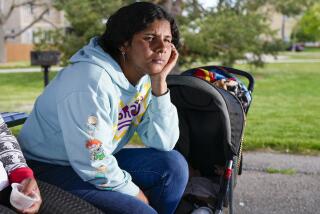Head Start Center Offers Haven of Hope to Migrant Workers’ Children : Families: The Parksley, Va., facility provides food, health care and a chance for minds to grow. Its expanded program may be a model for the future.
- Share via
PARKSLEY, Va. — Every morning before dawn, four school buses circle the migrant camps of Virginia’s eastern shore, picking up babies and preschool children and bringing them to a cinder-block building fragrant with baking bread and fresh laundry.
Many arrive filthy, sometimes with cockroaches in their shoes or lice in their hair, so the first stop of the day is the bathtub in the Parksley Migrant Head Start Center.
Once bathed, the children will spend the next 12 hours at the center, a refuge from crowded houses and shacks of the migrant camps, a place where everything is cooked from scratch and the toys are geared to each stage of their development.
The federal government wants more Head Start centers to look like Parksley. It’s filled with babies, toddlers and preschoolers, offers full services and is open all day.
Traditional Head Start centers also offer comprehensive child-development services to low-income children, but enrollment is generally limited to 4- and 5-year-olds and most programs are half-day.
But this year, Congress voted for the first time to expand Head Start to infants and toddlers. The decision reflects a growing recognition that the first three years of life lay the foundation for all that follows, and that a healthy start depends on a stable environment that is also stimulating, responsive, protective and loving.
A small percentage of Head Start’s overall budget--$106 million out of $3.5 billion in 1995--is devoted to programs serving children from birth to age 3.
Migrant Head Start, a $130-million system of 400 centers nationwide, has a 25-year history of working with infants and toddlers.
Republicans, who are taking control of Congress, have vowed to take a close look at all of the anti-poverty programs. Head Start won’t be exempt from the scrutiny, but the program has been widely popular with both Republicans and Democrats during its 29-year history.
The Parksley center has become so popular among the Mexican-American migrants that it is often their first stop when they arrive in trucks to pick vegetables on Virginia’s eastern shore, a narrow peninsula of graceful pines and silty fields between the Chesapeake Bay and the Atlantic Ocean.
The center, which serves a maximum of 88 children and operates on two shifts, fills up quickly, and at the height of the season there are often 60 children on the waiting list, says center director Joyce Dix.
Staff members say the children are taught good eating and health habits and given a daily health check before their baths. After family-style meals are served, anyone old enough to hold a toothbrush gathers around the sink to brush.
The staff is trained to spot any developmental problems, physical disabilities, and emotional and behavioral problems among the children. They look for children who aren’t crawling on time, learning to walk properly or able to hold a pencil as they get older.
“If they haven’t developed these skills, nine times out of 10 they’ll be left behind,” Dix said.
Dix said the parents, who work in the fields all day and in the packing sheds at night, may not have the time or experience to notice problems.
“If we don’t reach them in the first three years, we’re going to lose a lot of them,” said Jenni Stewart, program coordinator for the Virginia Council of Churches, which runs the Parksley center and four other Migrant Head Start programs in the state.
Poor dental hygiene is one of the most common problems of the children at Parksley, and the center occasionally arranges dental surgery for children whose baby teeth have rotted into painful splinters.
Donna Allshouse, a licensed practical nurse who is the center’s health and disabilities coordinator, says she also sees frequent ear infections, occasional lice and, in years past, identified total deafness in children whose parents were unaware of the problem.
Dix says this generation of children seems better off than their parents--some of the preschoolers are nearly as tall as their mothers--and Allshouse says it may be due in part to all the vitamins and good cooking they get in Parksley.
The families come from Texas and Florida, and have usually worked in Georgia and the Carolinas before they arrive in Virginia. When they finish on the shore, some head north to harvest cranberries in Massachusetts and blueberries in Maine.
Migrants are among the poorest-paid workers in the country, with median earnings of $5,000 in 1991, according to Monica Heppel, associate professor of anthropology at Mount Vernon College in Washington. She is a farm-labor expert who lived for a year in the camps on Virginia’s eastern shore.
Although the children travel long distances, Stewart says, they often know little about the outside world. The Parksley center tries to make up for the frequent upheavals in their lives and takes them on field trips to places like pet shops, pony farms and zoos.
“We try to build up their confidence,” said teacher Regina Pettit as the children sleep on their cots, covered in identical green blankets. “You’re the person they look to when they’re afraid or sad. It makes us feel good that they have a place like this to come to. We know they’re safe here.”
More to Read
Sign up for Essential California
The most important California stories and recommendations in your inbox every morning.
You may occasionally receive promotional content from the Los Angeles Times.













